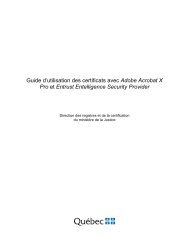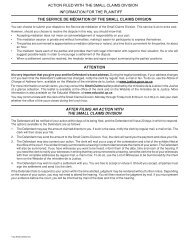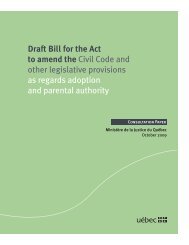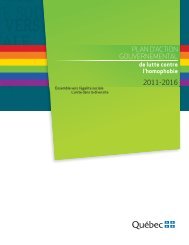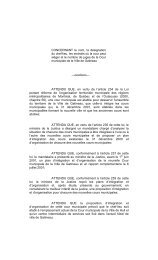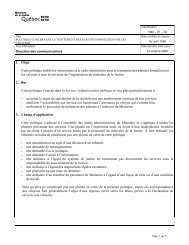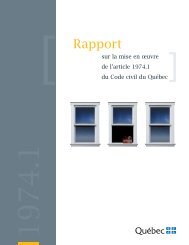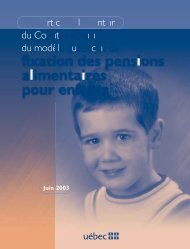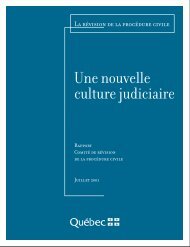guide on drafting court reports for use by certified addiction ...
guide on drafting court reports for use by certified addiction ...
guide on drafting court reports for use by certified addiction ...
Create successful ePaper yourself
Turn your PDF publications into a flip-book with our unique Google optimized e-Paper software.
ADDICTION TREATMENT PROGRAM OF THE COURT OF QUÉBEC (PROGRAMME DE TRAITEMENTDE LA TOXICOMANIE DE LA COUR DU QUÉBEC, OR PTTCQ)residence, state of health (medicati<strong>on</strong> and medical supervisi<strong>on</strong>), medical history(physical and mental health), suicide attempts (dates and circumstances) or not,and specialized treatment (current and past).3. PERSONAL AND SUBSTANCE USE HISTORYThis secti<strong>on</strong> must describe the key events in the offender’s pers<strong>on</strong>al history. It isdesigned to summarize the psycho-social elements that are relevant tounderstanding the offender’s substance <strong>use</strong> profile. It is important to c<strong>on</strong>centrate<strong>on</strong> elements c<strong>on</strong>nected with the offender’s addicti<strong>on</strong> that influence his or her pastor present substance <strong>use</strong>.The analysis of the elements of this secti<strong>on</strong> is essential and must describe theoffender’s substance <strong>use</strong> profile and establish links between the psycho-socialelements and the <strong>use</strong> of drugs or alcohol.The substance <strong>use</strong> history must c<strong>on</strong>tain the following elements: age andcircumstances when substance <strong>use</strong> began, psychoactive substances <strong>use</strong>d,habitual <strong>use</strong>, circumstances of <strong>use</strong>, reas<strong>on</strong>s <strong>for</strong> <strong>use</strong>, supply, history of previoustreatment, previous therapy (nature, number, place), periods of abstinence,important or significant events.The IGT, or any other assessment tool provided <strong>by</strong> the CDC-IUD <strong>use</strong>d to assessa pers<strong>on</strong> applying <strong>for</strong> the program, c<strong>on</strong>tains data <strong>on</strong> offender’s pers<strong>on</strong>al andsubstance <strong>use</strong> history that can be included in this secti<strong>on</strong> of the report.4. RESULTS OF TREATMENT / RESIDENTAL PROGRAMThis secti<strong>on</strong> must detail the offender’s progress in the therapeutic program andhighlight significant changes observed since the start of treatment. It must focus<strong>on</strong> the offender’s progress through the program stages and the offender’sspecific situati<strong>on</strong>. Using examples, the offender’s participati<strong>on</strong> in the therapygroups must be illustrated, al<strong>on</strong>g with the offender’s behaviour at the resourceand degree of involvement in his or her interventi<strong>on</strong> plan.The report <strong>for</strong>m must have a space <strong>for</strong> each stage. For example, the c<strong>on</strong>tent <strong>for</strong>Stage 1 must be placed in space 5.1, the c<strong>on</strong>tent <strong>for</strong> Stage 2 in space 5.2, andso <strong>on</strong>. This allows the <strong>court</strong> to assess the offender’s progress through each stageand to refer to the in<strong>for</strong>mati<strong>on</strong> provided previously.In short, the following elements c<strong>on</strong>cerning the offender’s situati<strong>on</strong> must benoted: treatment stage, objectives of the stage, interventi<strong>on</strong> plan, priority needs,therapeutic activities, participati<strong>on</strong> in the program (nature and quality ofparticipati<strong>on</strong>), difficulties and improvements observed, learning acquired, sharing5.
ADDICTION TREATMENT PROGRAM OF THE COURT OF QUÉBEC (PROGRAMME DE TRAITEMENTDE LA TOXICOMANIE DE LA COUR DU QUÉBEC, OR PTTCQ)activities, interacti<strong>on</strong>s and individual experiences, persistent problems,therapeutic progress, assessment of progress, validated tests administered,resp<strong>on</strong>sibilizati<strong>on</strong>, compliance with rules, breaches of discipline (reprimands,event involved and c<strong>on</strong>sequences, possibility of expulsi<strong>on</strong>), expulsi<strong>on</strong> (reas<strong>on</strong>s),leaves of absence (destinati<strong>on</strong>, durati<strong>on</strong>, reas<strong>on</strong>s, activities), therapeuticc<strong>on</strong>tract, relapses (c<strong>on</strong>text, substance, self-disclosed or not, offender’s posteventreacti<strong>on</strong>), and occupati<strong>on</strong>al or related activities.5. COMPLEMENTARY INFORMATIONThis secti<strong>on</strong> must c<strong>on</strong>tain in<strong>for</strong>mati<strong>on</strong> c<strong>on</strong>cerning addicti<strong>on</strong> detecti<strong>on</strong> tests, asfollows: date of test, result, reacti<strong>on</strong> of the pers<strong>on</strong> undergoing the test, measurestaken <strong>by</strong> the resource.The secti<strong>on</strong> is also intended to provide the <strong>court</strong> with relevant in<strong>for</strong>mati<strong>on</strong> <strong>for</strong> thecompensatory work program or community service orders that apply to theoffender, if any, as follows: the number of hours to accomplish, nature, locati<strong>on</strong>,durati<strong>on</strong> and program or work, name of supervisor.6. CONCLUSION AND RECOMMENDATIONThe c<strong>on</strong>tents of this secti<strong>on</strong> vary, depending <strong>on</strong> the stage of therapy c<strong>on</strong>cerned.The c<strong>on</strong>tent <strong>for</strong> Stage 1 must be entered in space 7.1, the c<strong>on</strong>tent <strong>for</strong> Stage 2 inspace 7.2 and so <strong>on</strong>. This allows the <strong>court</strong> to assess the offender’s progressthrough each stage and to refer to the in<strong>for</strong>mati<strong>on</strong> provided previously.6.1: Progress report / applicati<strong>on</strong> <strong>for</strong> ”revisi<strong>on</strong> of terms”This report must be filed approximately 8 weeks after therapy begins.This sub-secti<strong>on</strong> of the report must set out the reas<strong>on</strong>s in support of anapplicati<strong>on</strong> to change <strong>on</strong>e or more of the offender’s c<strong>on</strong>diti<strong>on</strong>s, such as remain atthe resource 24/7. The report allows the <strong>court</strong> to make an enlightened decisi<strong>on</strong>,based <strong>on</strong> clinical objectives <strong>for</strong> gradual social reintegrati<strong>on</strong>.6.2: Progress report / recommendati<strong>on</strong>The report must be filed approximately 8 weeks after the ”revisi<strong>on</strong> of terms”.This subsecti<strong>on</strong> must be fact-based and describe in detail the elements that canbe <strong>use</strong>d <strong>by</strong> the <strong>court</strong> to broaden the clinical objectives <strong>for</strong> social reintegrati<strong>on</strong>.6.3 : Final report and release plan6.
ADDICTION TREATMENT PROGRAM OF THE COURT OF QUÉBEC (PROGRAMME DE TRAITEMENTDE LA TOXICOMANIE DE LA COUR DU QUÉBEC, OR PTTCQ)This report must be filed approximately 8 weeks after the last progress report.The objective is to end residential treatment and to <str<strong>on</strong>g>guide</str<strong>on</strong>g> the offender towardsexternal treatment.This subsecti<strong>on</strong> must highlight the adaptati<strong>on</strong> factors that will promote successfulsocial reintegrati<strong>on</strong>. It must review relevance and feasibility based <strong>on</strong> theoffender’s ability and the existing c<strong>on</strong>text. It must list realistic objectives,achievable over the short and medium term. It must also state whether or not theoffender has a social network that will support social reintegrati<strong>on</strong>.In short, the final report must c<strong>on</strong>tain elements that describe the offender’ssituati<strong>on</strong> at a precise time: mobilizati<strong>on</strong> (ef<strong>for</strong>t, attitude, motivati<strong>on</strong>), socialnetwork (involved or not), c<strong>on</strong>cerned individuals (c<strong>on</strong>necti<strong>on</strong>, reliability), riskfactors, lifestyle habits requiring change, tools to prevent a relapse, ways tomaintain acquired learning and reduce the risk of relapse, analysis of ”revisi<strong>on</strong> ofterms”.The release plan must be drawn up <strong>by</strong> the offender and appended to the finalreport. It must set out a c<strong>on</strong>crete plan <strong>for</strong> social reintegrati<strong>on</strong>: objectives,c<strong>on</strong>crete steps, acti<strong>on</strong>s undertaken prior to release and to be c<strong>on</strong>tinued in thecommunity, educati<strong>on</strong>, employment, volunteer work (steps completed or to becompleted), leisure activities, residential address (whether or not there is achange of address).7.




